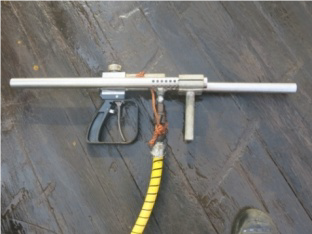LTI: Leg injury caused during HP water jetting
What happened?
During diving operations to clean a riser with a HP water jet type Cavitek, a diver cut his leg (thigh) with the water jet.

The incident occurred whilst the diver was not properly secured during the cleaning operation. The diver should always be comfortably and securely positioned during HP water jetting operations. It is especially important to ensure that this is so during mid-water work, otherwise there is a greater likelihood that the diver may lose control of the trajectory of the jet stream during jetting operations. The likelihood of such an event will also be increased if the retro jet and forward jet on the gun is strongly unbalanced.
Our member notes that there was an incorrect calculation of the HP hose length needed for this job. The minimum length of hose required per jetting gun unit is normally considered to be 1.5 times the maximum anticipated working depth. The length of the hose should not impact upon the comfort and security of the diver during HP water jetting operations.
The length of the waterjet lance may not have been appropriate (too short). The inherent potential for accidental self-injury during use of high pressure jetting guns increases as the length of lance (barrel) decreases.
Code of practice for the use of high pressure jetting equipment by diversstates:
“Hoses should be tied off at convenient locations to assist in minimising movement due to pressure supply changes or tidal/current movement.
Hoses should never be tied off to any part of any diving equipment.”
Key Lessons Learned
- Before water jetting operations:
- ensure proper and dedicated tool box talks are held
- ensure there us a full assessment of risks and needs at the work area
- check the required length of hose;
- When cleaning vertical parts of structures in mid-water divers should be rigged to be stable and comfortable for jetting operations;
- Check that the gun is appropriately designed, properly balanced, well-maintained and fit for purpose;
- Ensure the diver holds the gun with two (2) hands;
- Stop/release the trigger before each movement.
- Ensure regular communication from the diver to the dive supervisor about the situation at depth;
Remind the dive team of the importance of good communications and consistent observance of safe working practices.
Water jetting incidents:
Safety Event
Published: 3 May 2017
Download: IMCA SF 09/17
IMCA Safety Flashes
Submit a Report
IMCA Safety Flashes summarise key safety matters and incidents, allowing lessons to be more easily learnt for the benefit of all. The effectiveness of the IMCA Safety Flash system depends on Members sharing information and so avoiding repeat incidents. Please consider adding [email protected] to your internal distribution list for safety alerts or manually submitting information on incidents you consider may be relevant. All information is anonymised or sanitised, as appropriate.
IMCA’s store terms and conditions (https://www.imca-int.com/legal-notices/terms/) apply to all downloads from IMCA’s website, including this document.
IMCA makes every effort to ensure the accuracy and reliability of the data contained in the documents it publishes, but IMCA shall not be liable for any guidance and/or recommendation and/or statement herein contained. The information contained in this document does not fulfil or replace any individual’s or Member's legal, regulatory or other duties or obligations in respect of their operations. Individuals and Members remain solely responsible for the safe, lawful and proper conduct of their operations.
